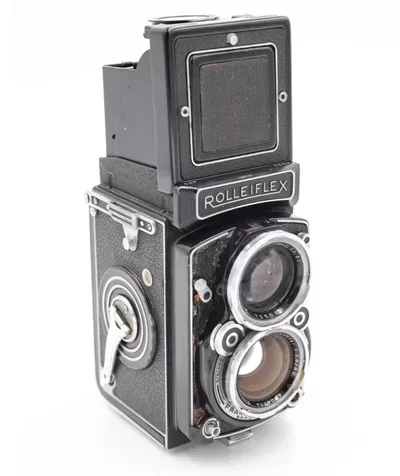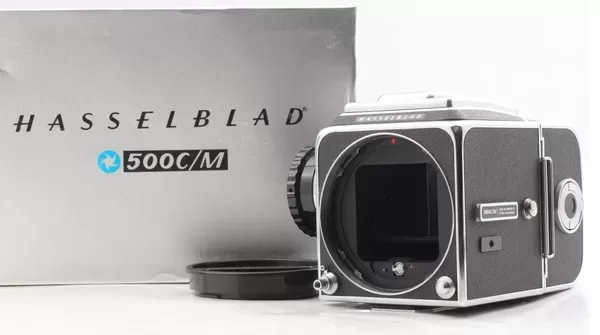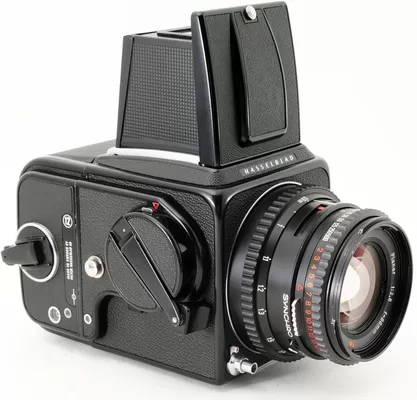A Comparison of Rolleiflex and Hasselblad Cameras – Are you thinking of getting into film photography and want the best camera possible? Rolleiflex and Hasselblad cameras have been used by the world’s top professionals. Which one is right for you?
These iconic brands have left an indelible mark on the history of photography, each with its own unique strengths and characteristics. In this blog post, we’ll delve into the nuances of these two legendary camera systems to help you understand what sets them apart.
Rolleiflex: Timeless Elegance
For many photographers, the name Rolleiflex conjures images of classic elegance and unmatched craftsmanship.


Founded in Germany in 1920, Rolleiflex gained renown for its twin-lens reflex (TLR) cameras, which featured a distinctive top-down viewing system.
One of the defining features of Rolleiflex cameras is their exceptional build quality. Crafted from premium materials with meticulous attention to detail, these cameras are a testament to German engineering at its finest.
The smooth operation of the controls, the precision of the lenses, and the durability of the construction all contribute to the enduring appeal of Rolleiflex cameras.
In addition to their superior build quality, Rolleiflex cameras are beloved for their image quality.
Equipped with high-quality lenses and a square format that lends itself to artistic composition, Rolleiflex cameras are capable of producing stunning images with rich detail and timeless appeal.
See more details on the Rolleiflex 2.8C TLR 120 Film Camera
Rolleiflex 2.8
The Rolleiflex 2.8 is part of the Rolleiflex TLR (twin-lens reflex) series, which has been cherished by photographers for its classic design, exceptional build quality, and superior image rendering.
- Twin-Lens Reflex Design: The Rolleiflex 2.8 features a unique twin-lens reflex design, with one lens for taking the photograph and another for composing the image through a waist-level viewfinder. This design provides a distinct shooting experience and lends itself to precise composition.
- Carl Zeiss Optics: Like its Hasselblad counterpart, the Rolleiflex 2.8 is equipped with high-quality Carl Zeiss optics. The lenses are renowned for their exceptional sharpness, contrast, and color rendition, producing images with a timeless quality.
- Leaf Shutter: Similar to the Hasselblad 500 series, the Rolleiflex 2.8 utilizes a leaf shutter mechanism located within the lens. This design allows for flash synchronization at all shutter speeds, making it well-suited for studio photography and other applications where precise timing is crucial.
- Portability: Despite its robust construction, the Rolleiflex 2.8 is surprisingly compact and portable, making it an ideal companion for photographers on the go. Its lightweight design and intuitive controls make it a favorite among street photographers and documentary photographers.


Hasselblad: Innovation and Excellence
In contrast to the classic elegance of Rolleiflex, Hasselblad cameras exude a sense of modernity and innovation. Founded in Sweden in 1941, Hasselblad quickly established itself as a leader in medium format photography, thanks in large part to its groundbreaking work with NASA.
One of the hallmarks of Hasselblad cameras is their modular design. Unlike traditional SLR cameras, which are built around a fixed body, Hasselblad cameras feature interchangeable components that allow photographers to customize their setup to suit their specific needs. This modular design not only enhances versatility but also facilitates easy maintenance and repair.
Another key feature of Hasselblad cameras is their exceptional image quality. With renowned lenses known for their sharpness, clarity, and color rendition, Hasselblad cameras are favored by discerning photographers who demand nothing but the best. Whether shooting portraits, landscapes, or still life, Hasselblad cameras consistently deliver breathtaking results.
Read more: Hasselblad 500C/M
Hasselblad 500 series
The Hasselblad 500 series, introduced in the late 1940s, represents a pinnacle of medium format photography. The most iconic model in this series is the Hasselblad 500C/M, which became synonymous with professional photography and was even used by NASA for space missions.
- Modular Design: One of the defining features of the Hasselblad 500 series is its modular design. The camera body, film back, viewfinder, and lens are all separate components that can be easily interchanged. This modularity allows photographers to customize their setup according to their specific needs and preferences.
- Leaf Shutter: The Hasselblad 500 series cameras are equipped with a leaf shutter mechanism built into the lens. This design allows for flash synchronization at all shutter speeds, making them ideal for studio work and flash photography.
- Zeiss Lenses: Hasselblad forged a legendary partnership with Zeiss, one of the world’s most renowned lens manufacturers. The lenses produced for the Hasselblad 500 series are revered for their exceptional optical quality, sharpness, and clarity.
- Waist-Level Finder: The waist-level finder of the Hasselblad 500 series allows photographers to compose their shots from a low vantage point. This unique viewing perspective can lead to more creative compositions and is particularly well-suited for portrait and street photography.
The Verdict
So, which is better: Rolleiflex or Hasselblad? The truth is, it ultimately comes down to personal preference and the specific needs of the photographer. Rolleiflex cameras appeal to those who appreciate classic design, impeccable craftsmanship, and the timeless allure of medium format photography. On the other hand, Hasselblad cameras cater to photographers who value innovation, versatility, and uncompromising image quality.
Whether you choose the timeless elegance of a Rolleiflex or the cutting-edge innovation of a Hasselblad, one thing is certain: both of these legendary camera brands have earned their place in the pantheon of photographic excellence. Whichever path you choose, you can rest assured that you’ll be capturing brilliance with every click of the shutter.
Both the Hasselblad 500 series and the Rolleiflex 2.8 are revered for their exceptional craftsmanship, superb optics, and timeless design. Whether you prefer the modular versatility of the Hasselblad or the classic charm of the Rolleiflex, both cameras offer a unique shooting experience and the ability to capture images of unparalleled quality. Ultimately, the choice between the two comes down to personal preference and the specific needs of the photographer.
Reviews
Hasselblad 500CM and the Rolleiflex 2.8D, each equipped with the renowned Zeiss 80/2.8 Planar lens. Both cameras are incredibly reliable and sturdy, especially when maintained properly. Designed with the demands of the professional market in mind, they excel even under rigorous conditions. I’ve taken both cameras on extensive multi-day hikes and international travels, and they’ve performed flawlessly throughout.
The Rolleiflex 2.8D stands out for its noticeably lighter and more compact build compared to the Hasselblad 500CM, especially when paired with the 80mm lens. This size advantage becomes even more apparent when using alternative lenses.
Choosing between the two ultimately boils down to your preference for a modular system. If you prioritize the ability to swap lenses and backs, the Hasselblad is the clear choice. However, if this flexibility isn’t a priority, I believe the Rolleiflex offers a superior camera experience overall.
Reviews
The f/3.5 Planar lens is another standout option, offering stellar performance in a lighter package. While the weight difference may not seem significant when compared to other camera systems, it’s notable when considering Rollei’s own lineup. Both the weight and balance of the camera feel noticeably different with the f/3.5 lens attached. If you can work with the f/3.5 aperture, it’s likely the preferable choice, and the lens itself can deliver exceptional image quality.
The recommendation for the Mamiya 6 is solid, particularly if you’re comfortable with a rangefinder focusing system. The lenses on the Mamiya 6 are renowned for their excellence, ensuring you won’t compromise on image quality compared to the Hasselblad.
In the grand scheme, the options discussed here represent the cream of the crop. There’s no wrong choice among them, as each offers top-tier performance and the potential to capture phenomenal images. Ultimately, it boils down to personal preference. Whichever option you go with, you can trust that it will serve you well and deliver outstanding results.
Reviews
I have various models of both Rollei and Hasselblad cameras in my collection. One challenge I’ve encountered with Rollei cameras is the prevalence of mold or haze in the lenses, particularly those stored in the leather cases that were commonly provided. Unfortunately, this issue has made it increasingly difficult to find a Rollei camera at a reasonable price that doesn’t suffer from these optical imperfections.
Given this concern, I highly recommend considering a Hasselblad 500C/M or even investing in the upgraded 503CX if it’s within your budget. The Hasselblad system is renowned for its exceptional quality and versatility, and I speak from experience—I own the complete range of lenses for this system. With Hasselblad, you can trust in the reliability and performance of their cameras and lenses, making it a worthwhile investment for any serious photographer.
Reviews
Ah, the Rolleiflex SL66—a true hybrid of both worlds! This camera holds a special place in the hearts of many photographers, offering a unique blend of features from both the Rolleiflex and Hasselblad systems.
What sets the Rolleiflex SL66 apart is its versatility, particularly for macro photography enthusiasts. With the ability to mount lenses in reverse directly onto the camera body, without the need for additional accessories, it becomes an incredibly handy tool for close-up work. Plus, the built-in bellows with tilt functionality add a whole new dimension to creative composition.
However, it’s worth noting that the SL66 does come with its own set of considerations. Unlike its TLR Rolleiflex counterparts, the SL66 features a focal plane shutter. While this offers certain advantages, such as higher shutter speeds, it does mean that achieving fast flash sync requires lenses equipped with a built-in leaf shutter. Additionally, servicing these specialized lenses may prove to be more challenging due to their relative rarity compared to standard Rolleiflex or Hasselblad equipment.
In essence, the Rolleiflex SL66 is a fascinating amalgamation of classic design and innovative features, offering a compelling option for photographers who crave versatility and creativity in their medium format endeavors.
Reviews
I own both the Hasselblad 500C and the Rolleiflex 2.8C, and I must say, both cameras are built to withstand the test of time. They exude durability and reliability, earning their reputation for being as sturdy as tanks.
When it comes to travel photography, the Rolleiflex edges out slightly in terms of weight. Though the difference may seem subtle, you can definitely feel it when holding both cameras simultaneously.
As many others have pointed out, the decision between the two largely hinges on your preference for interchangeable parts. If you’re content with sticking to the 80mm lens for most of your shooting needs, then the Rolleiflex would be an excellent choice. However, if you envision yourself needing different focal lengths—a versatile setup with an 80mm for everyday shots and a 150mm for portraits, for instance—then the Hasselblad might be better suited to your needs.
In the end, it’s all about finding the camera that aligns best with your shooting style and preferences. Whether you opt for the rugged reliability of the Hasselblad or the lightweight convenience of the Rolleiflex, both cameras have the potential to capture stunning images and serve you faithfully for years to come.
Camera Reviews with a word on why collect that camera
| Leica M3 ° street, photojournalism Hasselblad 500C/M ° square fashion Nikon F ° press reportage, sport Rolleiflex TLR ° portraits Bronica 645 ° aerial | Contax IIa/IIIa ° affordable Leica Olympus OM2n ° low light Polaroid Land Camera ° novelty, studio test Kodak Brownie ° novelty Nikonos III 35mm ° underwater film camera |
Related stories
Guide to Collecting Vintage Film Cameras






